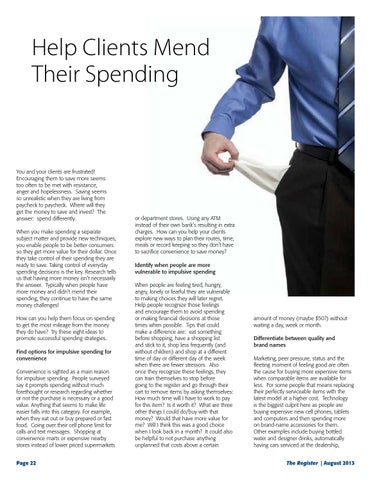Help Clients Mend Their Spending
You and your clients are frustrated! Encouraging them to save more seems too often to be met with resistance, anger and hopelessness. Saving seems so unrealistic when they are living from paycheck to paycheck. Where will they get the money to save and invest? The answer: spend differently. When you make spending a separate subject matter and provide new techniques, you enable people to be better consumers so they get more value for their dollar. Once they take control of their spending they are ready to save. Taking control of everyday spending decisions is the key. Research tells us that having more money isn’t necessarily the answer. Typically when people have more money and didn’t mend their spending, they continue to have the same money challenges! How can you help them focus on spending to get the most mileage from the money they do have? Try these eight ideas to promote successful spending strategies. Find options for impulsive spending for convenience Convenience is sighted as a main reason for impulsive spending. People surveyed say it prompts spending without much forethought or research regarding whether or not the purchase is necessary or a good value. Anything that seems to make life easier falls into this category. For example, when they eat out or buy prepared or fast food. Going over their cell phone limit for calls and text messages. Shopping at convenience marts or expensive nearby stores instead of lower priced supermarkets Page 22
or department stores. Using any ATM instead of their own bank’s resulting in extra charges. How can you help your clients explore new ways to plan their routes, time, meals or record keeping so they don’t have to sacrifice convenience to save money? Identify when people are more vulnerable to impulsive spending When people are feeling tired, hungry, angry, lonely or fearful they are vulnerable to making choices they will later regret. Help people recognize those feelings and encourage them to avoid spending or making financial decisions at those times when possible. Tips that could make a difference are: eat something before shopping, have a shopping list and stick to it, shop less frequently (and without children) and shop at a different time of day or different day of the week when there are fewer stressors. Also once they recognize these feelings, they can train themselves to stop before going to the register and go through their cart to remove items by asking themselves: How much time will I have to work to pay for this item? Is it worth it? What are three other things I could do/buy with that money? Would that have more value for me? Will I think this was a good choice when I look back in a month? It could also be helpful to not purchase anything unplanned that costs above a certain
amount of money (maybe $50?) without waiting a day, week or month. Differentiate between quality and brand names Marketing, peer pressure, status and the fleeting moment of feeling good are often the cause for buying more expensive items when comparable items are available for less. For some people that means replacing their perfectly serviceable items with the latest model at a higher cost. Technology is the biggest culprit here as people are buying expensive new cell phones, tablets and computers and then spending more on brand-name accessories for them. Other examples include buying bottled water and designer drinks, automatically having cars serviced at the dealership, The Register | August 2013
